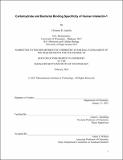Carbohydrate and bacterial binding specificity of human intelectin-1
Author(s)
Isabella, Christine R.(Christine Rose)
Download1252627562-MIT.pdf (12.57Mb)
Other Contributors
Massachusetts Institute of Technology. Department of Chemistry.
Advisor
Laura L. Kiessling.
Terms of use
Metadata
Show full item recordAbstract
The mucosal surfaces of the human body exist in close contact with complex communities of resident microorganisms termed the microbiome. The microbiome is crucial for host health, and therefore the host must discern between which microbes colonize and which must be cleared. Human soluble lectins are secreted carbohydrate-binding proteins that bind microbes by specific recognition of cell surface glycans. Many soluble lectins are important mucosal innate immune factors, as lectins binding to microbes can result in their clearance from the host. However, the glycan and microbial binding specificities of lectins are poorly defined. In this thesis, I aim to address this gap with a focus on human intelectin-1 (hItln-1). In Chapter 1, I review the recently identified class of lectins, the X-type lectins. The X-type lectins, or intelectins, are found throughout chordates and share highly conserved sequences but their biological roles are not well understood. However, their expression patterns and microbial binding specificity suggest a role in regulation of the microbiome. In Chapter 2, I build on previous work to further define hItln-1 carbohydrate specificity. These studies reveal that carbohydrate conformation is stabilized by stereoelectronic effects, and that carbohydrates are bound by hItln-1 in their stabilized conformation. In Chapter 3, I turn to bacterial cell recognition by hItln-1 and determine that hItln-1 displays competitive binding to bacterial strains in a mixture. These studies reveal the need to assay lectin-bacteria recognition against diverse microbial communities to understand their binding specificity in a biological context. In Chapter 4, I develop lectin-sequencing (lectin- SEQ) as a method for identifying bacterial targets of lectins in native communities. Using the human stool microbiome, I assess binding to stool bacteria by hItln-1, and surfactant protein-D (SP-D). Lectin-SEQ reveals that hItln-1 recognizes health-promoting commensal bacteria, while SP-D recognizes pathogenic bacteria. These results indicate a novel role for hItln-1 in promoting colonization of commensal bacteria.
Description
Thesis: Ph. D., Massachusetts Institute of Technology, Department of Chemistry, February, 2021 Cataloged from the official PDF of thesis. Includes bibliographical references.
Date issued
2021Department
Massachusetts Institute of Technology. Department of ChemistryPublisher
Massachusetts Institute of Technology
Keywords
Chemistry.